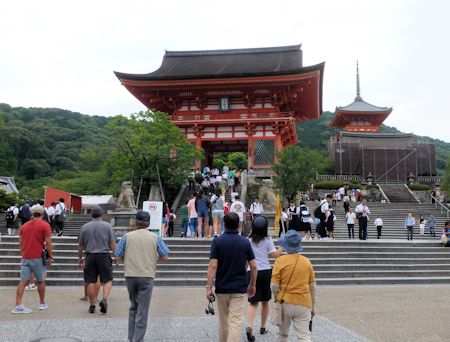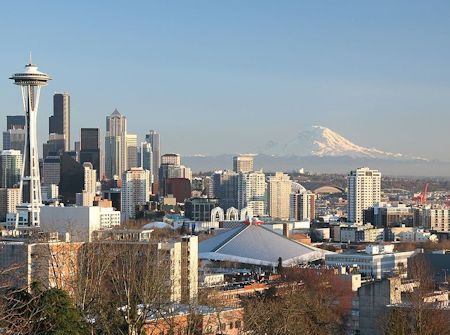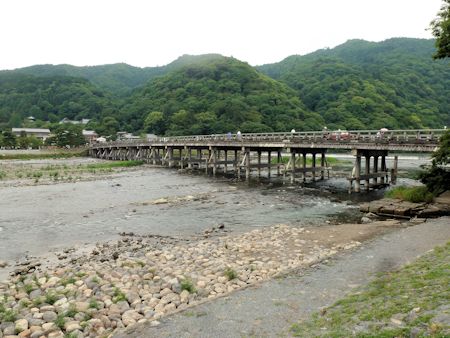|
 |
|
|
|
|
5th Day (Thursday, June 29)
Sightseeing Bus Tour |
|
Got up at 6:00. Breakfast is in the room with foods in hand bought at Lawson
yesterday.
We are going to ride on the one-day bus tour. The first spot is Kiyomizu-dera
Temple, then walking around Arashiyama, visiting Tenryuji Temple, and on
the way back, visiting Kinkakuji Temple and Toji Temple. |
|
| - - - - - - - - - - |
|
Kiyomizu-dera Temple
|
|
Well known for its "Kiyomizu-no-butai" veranda, just out of the
side of a mountain, Kiyomizu-dera Temple was founded in 778, early Heian
period, by Sakanoue-no-Tamuramaro and the high priest Enchin, and its present
buildings were constructed in 1633, ordered by the Tokugawa Ieyasu. The
main hall (National Treasure), with its stage-like architecture, protrudes
over a cliff and offers a magnificent view of the Kyoto cityscape.
There is not a single nail used in the entire structure. It takes its name from the waterfall within the complex, which runs off the nearby hills. Kiyomizu means clear water, or pure water.
The beauty of the backdrop changes over the seasons, including the cherry
blossoms, new green leaves of spring and the colors of the folliage in
autumn. There are many cultural assets in the temple precincts, including
the Okuno-in and Amida-do (both Important Cultural Properties).
It was originally affiliated with the old and influential Hossō sect dating from Nara times. However, in 1965 it severed that affiliation, and its present custodians
call themselves members of the "Kitahossō" sect.
(The Temple's website and Wikipedia) |
|
|
|
Going up the slow slope, called Kiyomizu Slope, looking restlessly at the
stores lined on both sides, we passed through Nio (Deva) Gate, which is
a tower-gate with a gabled, hipped roof made of cypress bark.

This was the entrance and here we received the worshipping ticket with the following description on the rear side.
Kiyomizu-dera Temple of Mt. Otowa is the stamp office for temple number
16 of the Saigoku Sanjusankasho Kannon Pilgrimage (the 33 temples that
are visited during the Kansai), and the pilgrim's hymn is;
松風や音羽の滝の清水を
むすぶ心はすゞしかるらん
We headed for the Main Hall, looking at the three-story pagoda and Kyodo
Hall (sutra library) on the right.
Main Hall was built in Kan-ei 10 (1633). Taking a sweeping glance inside,
we went up the steps and got to the Stage of Kiyomizu. But this stage had
still been long under repair, so we could not stand on it both last time
and this time.
After getting out of Main Hall, we walked slowly, seeing Jishu Shrine,
Facing-west Jizo Hall, Shaka Hall, 100-Statue Jizo Hall, and finally got
to Koyasu Tower next to Oku-no-in.
We are here in the precincts of Taisanji Temple, a tacchu (sub-temple)
of Kiyomizu-dera. The tower itself was nice, but the view from here toward
Main Hall was splended.
At least to me Otowa Falls is very famous for the rakugo "hatena-no-chawan"
(a teacup of question mark).
My favorite comic storytellers of this program are Beicho and Shinsho,
and also several others left theirs in CDs. It is the most suitable sleeping
pill for me.
Kiyomizu-dera Temple, Other Pictures
Pictures at the Visit on March 30
Incidentally, 3 months ago on March 30, before visiting Kiyomizu-dera Temple,
we stopped at Nanzenji Temple and Eikando Temple, and then from Wakaoji
Bridge until the place near Ginkakuji Temple we walked along the Road of
Philosophy.
The following links are the then pictures.
Pictures at Nanzenji Temple, March 30
Pictures at Eikando Temple, March 30
Pictures along the Tetsugaku-no-michi Road, March 30
- - - - -
A family of 4 (husband, wife and 2 children) from Seattle, the US, joined
in this tour.
I was able to have a small talk with the middle-aged couple in the bus
during the long way to Tenryuji Temple of Arashiyama.
About 40 years ago I was in the sales department of steel castings at Tokyo
Office of Daido Steel, and looking for the sales possibility of steel-casting
frogs or railroad crossings to the US and Canada.
It is doubtful if Seattle was the place to stop at for business then, but
I really visited this city once during the time. I clearly remember Mt.
Rainier even now. It is over 4,000 meters high, and a friend stationed
there drove me to the mountainside.
The following picture is from Wikipedia. Such beautiful scenery at that
time. Why? No pictures of mine then are found in the hard disc.

Aside from the talk about Ichiro, a baseball player, I was absorbed in
my story and they seemed to appreciate it much more. Then, their story
about their hometown. Famous companies there appear one after another;
Boeing of airplanes, Starbucks of coffee, Amazon of IT, Microsoft, Nintendo,
and Costco, the largest American membership-only warehouse club. Seattle's
sister city in Japan is said Kobe.
We talked and talked, and finally they suggested me in a serious smile
to taste raw fish meal at any Japanese restaurant next time in the city
facing the Pacific Ocean.
- - - - -
The days with Daido Steel after the graduation from university until the
age of 48 when I resigned it were the important period of my life.
4 years ago in 2013 I made a firm resolution to write the memories during
those days as a private novel titled by "ぼくの速玉時代". It is in the
Zakki-cho Square (the 79th-83rd story). Especially I miss the several years
when I looked for the possibility to export the steel castings, stationed
at Tokyo Branch Office.
The manager of technology department in Tsukiji Plant and I, manager of
Steel Casting Sales, as a tag team, made a regular business trip to North
America once half a year under the great expectation and support of the
Casting Division. This leads to my stationing at Daido Steel America in
New York City from 1942.
Two years ago in 2015, I translated the above novel into English titled
by "Taiji Miwasaki, Days with Hayatama Steel", which is the 96th
story in the same square.

Shinkansen Rails, near Shinagawa Station |
|

Tsukiji Plant of Daido Steel |
|

Chessie System Railroad, the US |
|
| - - - - - - - - - - |
| Tenryu-ji Temple |
|
"Tenryu-ji" (Temple of the Heavenly Dragon), located in the Sagano district of Kyoto, is the head temple of the Tenryu-ji branch of Rinzai Zen Buddhism. It was established in 1339 by the shogun Ashikaga Takauji in memory of Emperor Go-Daigo, who died in Yoshino following the civil war that brought the Ashikaga family to power. The eminent Zen master Muso Soseki was appointed the temple's founding abbot.
The site of Tenryu-ji had earlier been occupied by the temple Danrin-ji,
established in the ninth century and historically significant as the first
Zen temple in Japan. In the 13th century Emperor Kameyama built a villa
on the property, and it was here that Go-Daigo, his grandson, was raised
and educated. With Go-Daigo's passing Ashikaga Takauji ordered the villa's
conversion to a Zen temple.
In order to finance the temple's construction, Muso Soseki commissioned
a vessel, known as the Tenru-ji Ship, on a trademission to Yuan-dynasty
China. By 1343 most of the major buildings of the temple were completed.
Soseki's leneage prospered, playing a leading role in the flourishing Zen
literary culture known as gozan bungaku. Tenryu-ji itself was ranked first of the "Five Zen Mountains of
Kyoto" (Kyoto Gozan).
In the centuries since its founding, Tenryu-ji has been ravaged by fires a total of eight times, most recently in 1864. Most of the present buildings thus date only to the Meiji period (1868-1912). However, the landscape garden behind the Hojo (Main Hall) is one of the oldest in Japan, retaining the same form as when it was designed by Muso Soseki in the 14th century. Known as the Sogenchi Garden, it was the first Special Historical Scenic Area named by tbe Japanese government, and in 1994 it was designated by the United Nations as a World Cultural Heritage site.
(Tenryu-ji Temple's Pamphlet) |
|
|
|
We strolled around Sogenchi Garden, a type of Japanese garden with a pond
in the center. On the back of the abbot's chamber white sand is laid all
over, which is characterized by Kameyama Mountain as the natural scenery
around it.
|
|
|
It was such a visit to appreciate the simple and refined beauty of Sogenchi
Garden like an ink painting said to be created by Muso Soseki, an excellent
garden designer, and to be surprised by "Unryu-zu" (the painting
of Dragon in Clouds).
Tenryu-ji Temple, Other Pictures
The starting and ending point around Arashiyama was Togetsu-kyo Bridge,
and lunch at a Japanese restaurant near by.

Togetsu-kyo Bridge and the Neighborhood, Other Pictures
|
|
| 膝つきて古刹の芝の草むしり |
| 半夏雨木目浮き立つ阿弥陀仏 |
| 渡月橋に触れて戻りぬ冷奴 |
| Emiko |
|
| - - - - - - - - - - |
Kinkaku (The Golden Pavilion)
Rokuon-ji Temple |
|
Kinkaku (The Golden Pavilion) is a shariden, a Buddhist hall containing relics of Buddha. The pavilion is part of a temple that is formally named Rokuon-ji Temple, but commonly called Kinkaku-ji Temple or Temple of the Golden Pavilion. Rokuon-ji is a Zen Buddhist temple, in the Shokokuji-School of the Rinzai Sect.
This area was originally the site of a villa called Kitayama-dai and owned
by a statesman, Saionji Kintsune. Ashikaga Yoshimitsu, the 3rd shogun of
Muromachi period, took a liking to the area and acquired it from the Saionji
family in 1397. He then built his own villa, which he named Kitayama-den.
The garden and buildings, centered on the Golden Pavilion, were said to
represent the Pure Land of Buddha in this world. The villa also functioned
as an official guesthouse, welcoming Emperor Gokomatsu (Father of Zen teacher
Ikkyu) and the villa reached its height of glory as the heart of what became
known as Kitayama Culture.
After Yoshimitsu died, in keeping with his will, the villa was converted
into a temple by the priest Muso-kokushi, who became the first abbot. The
temple's name, Rokuon-ji, was derived from the name Yoshimitsu was given
for the next world, Rokuon-in-den.
In 1994, Rokuon-ji Temple was registered as a World Cultural Heritage Site.
(Rokuon-ji Temple's Pamphlet) |
|
|
|
Since my expectation was some much more showy appearance here, I was honestly
diappointed at the sight of simple Shariden (a hall which houses a relic
or bone of the Buddha), generally called "Kinkakuji Temple" just
in front.
But staring further at it with the opposite sight reflected on the pond,
I was convinced of the real Kinkakuji with no meaning.
The guidebook states about the so-called Kinkakuji as follows.
Gold foil on lacquer covers the upper two levels of Kinkaku, and a shining
phoenix stands on top of the shingled roof. The first level is built in
the shinden style of the 11th-century imperial aristocracy; the second
level is in buke style of the warrior aristocracy; and the top level is
in the Chinese Zenshu-butsuden style. Overall, Kinkaku is representative
of Muromachi-period architecture.
(Rokuon-ji Temple's Pamphlet) |
The novel "Kinkakuji" written by Yukio Mishima is in my mind.
It is one of his masterpieces and the theme is the arson case occurred
in Showa 25 (1950), which is often quated when talking about the present
building.
Whether I had ever read it or not, this novel flitted across my mind.
|
|
|
Kinkakuji Temple, Other Pictures
|
|
|
|
| - - - - - - - - - - |
| Toji Temple |
|
|
Half a century ago, I saw the movie in which the samurai Kurama-tengu casted
by Kanjuro Arashi fights a dual with Kondo Isami. I don't know why, but
I remember the background of the dual was Five-story Pagoda of Toji Temple.
Therefore, if you say "Toji Temple", as embarrassing as this
is to say, only Five-story Pagoda comes out to me just for now.
Toji is not that kind of temple. According to the temple's pamphlet;
|
In 794, when the capital of Japan was transferred to Kyoto from Nara, two
huge guardian temples were built on the east and west sides of the main
entrance of the Imperial City of Heian-kyo (the former name of the city
of Kyoto). Unfortunately, the temple on the west side no longer exists,
but To-ji, which literally means "East Temple", has survived
to the present day.
In 823, the Emperor Saga honored the monk Kukai and gave the temple to
him. Kukai made To-ji the central seminary of Shingon (or Esoteric) Buddhism
and added various buildings such as the pagoda and halls. Since then, To-ji
has been the headquaters of the Shingon sect of Japanese Buddhism. The
major buildings were damaged by earthquakes and fires but have been rebuilt
to retain the original layout and the architectural styles. Many magnificent
treasures such as statues, carvings, paintings and artworks are housed
in these temple buildings.
(To-ji Temple's Pamphlet)
To-ji Temple's Goeika (Buddhist hymn) is sung as follows.
The body remains in Mount Koya
and the mind lives in Toji
(身は高野 心は東寺に おさめおく
大師の誓い 新たなりけり)
It is said that Priest Kukai opened Mount Koya as the place for Zen austerities
and practiced the obtained wisdom here.
Since the foundation, this temple lost most of the buildings by disasters
a lot of times like typhoons, thunders, fires caused by war, etc., but
reconstruction was done each time with the power of common people' faith.
Especially Five-story Pagoda has shown the original appearance as the symbol
of the entrance of Ancient Kyoto.
|
This is my second visit here following last March, and got strong impression
on Five-story Pagoda this time too, anyway. On the other hand, my memory
is already vague about Golden Hall, Main Hall and Daishi Hall, though toured
each inside. Really a waste!
|
|
|
To-ji Temple, Other Pictures
Pictures at the Visit on March 28
|
|
|
|
|
|
After the today's tour, we took the subway from Kyoto Station and arrived
at the hotel before 5:00 p.m. Immediately took shower to wash off the sweat
and fatigue.
Dinner is at Otoya restaurant near the hotel. It is a chain store. I once entered the one somewhere around Tokyo. The main menu are almost the same rice sets.
Emiko followed the menu and I selected a couple of snacks to go with sake.
|
|
|
|
|
|
|
|
|
|
|
|
|
|